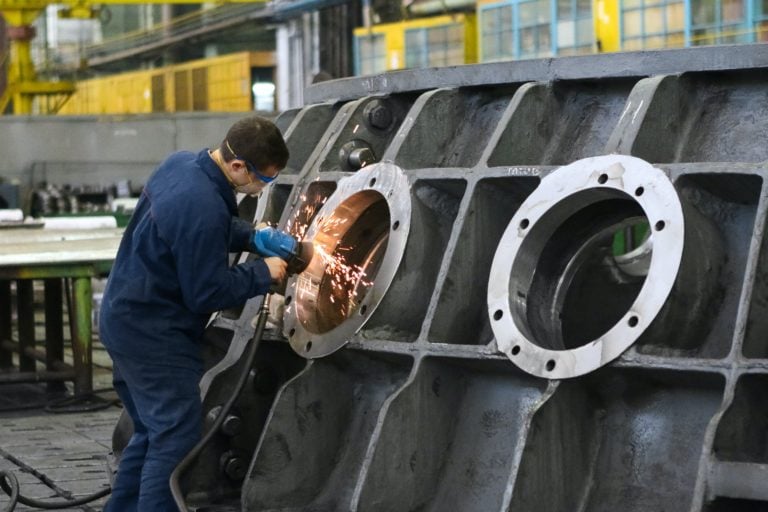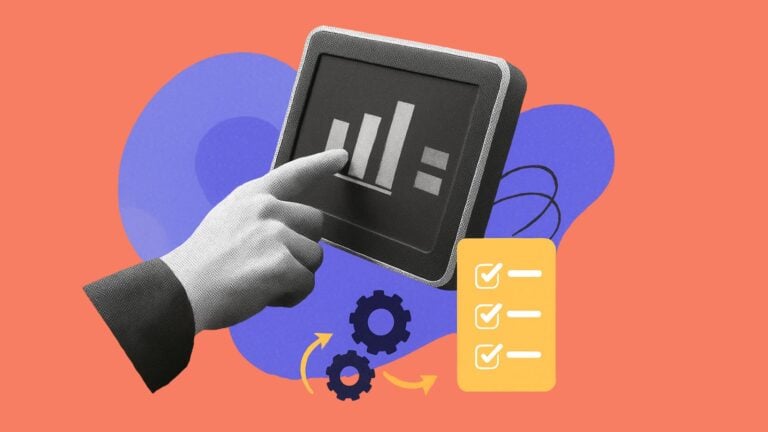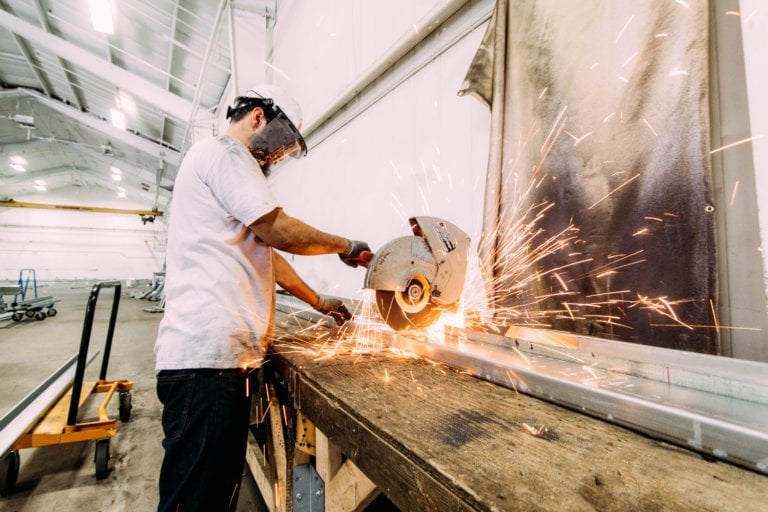By embracing digital transformation, manufacturers can be more productive, innovative, and agile. In this article, we take a closer look at digital transformation in the manufacturing industry—exploring benefits, challenges, future trends, and more.
Key Takeaways
- Digital transformation in manufacturing brings together modern technology and traditional manufacturing processes.
- Examples of digital technologies in the manufacturing industry include automation, artificial intelligence (AI), machine learning, 3D printing, and the internet of things (IoT).
- By embracing digital transformation, manufacturers can reduce errors, increase operational efficiency, improve agility, and more.
- Common challenges of digital transformation include choosing the right technologies and dealing with change.
- Having a clear implementation strategy in place will help you enable digital transformation in your business.
Digital transformation, also known as “Industry 4.0,” marks a new era in manufacturing. Manufacturers are using technology to work better, faster, and with fewer costs. By harnessing modern systems and tools, they also experience increased productivity, improved operational efficiency, and better customer satisfaction.
But what are the common digital transformation technologies in the manufacturing industry, and what challenges come with them? How can manufacturers successfully implement them?
We’re here to answer those exact questions. In this article, we take a deeper look at manufacturing digital transformation technologies, their challenges, and their benefits.
What Is Digital Transformation in Manufacturing?
Digital transformation in manufacturing refers to using digital technologies to improve manufacturing processes.
Digital transformation examples in manufacturing include automation, artificial intelligence (AI), and the internet of things (IoT). Another example is cloud-based document storage, which allows manufacturing professionals to store and access all checklists and other manufacturing documents from a single location.
Manufacturers can use these technologies for many different purposes. These include quality control, people management, and production processes, among many others. Digital transformation strategies can be implemented either as a wholesale system or as individual software.
Overall, digital transformation in manufacturing is about using modern technology to make factories more efficient and advanced. It enables manufacturers to easily adjust production to changing conditions, requirements, and consumer demands. It also allows them to streamline workflows, improve management, optimize production, and make more informed decisions. This leads to faster production times, better-quality products, and more satisfied customers.
What Are the Benefits of Manufacturing Digital Transformation?
Companies that use advanced technologies in their manufacturing processes can experience many benefits. These include:
Reduced human errors
Digital transformation in manufacturing automates tasks, eliminates manual data entry, and relies on more efficient digital operations. This reduces the likelihood of human errors.
Increased operational efficiency
Digital transformation can help you increase your operational efficiency. Automating processes can reduce manual labor and streamline production. AI can identify patterns and suggest optimizations for improved performance. Meanwhile, IoT can connect machines and enable them to exchange data in real time. This minimizes downtime and enables predictive maintenance.
Improved customer experience
By using digital transformation technologies like automation and AI, you can offer customers a better experience. They’ll enjoy streamlined access to information and more efficient ordering systems.
Better communication and collaboration
Digital transformation technologies can lead to greater internal communication and collaboration. When they communicate and work together well, employees make fewer errors and are more productive. Improved communication also minimizes the risk of misunderstandings and lost information.
One way to achieve this is by using software with built-in communication tools such as instant messaging. Connecteam, for example, offers an in-app chat and company newsfeed. Employees can communicate with each other in real time, no matter where they are.
Improved decision-making
Digital transformation in manufacturing can improve decision-making through data and analytics. You can use software that collects data from various sources. Then, you can analyze this data and gain insight into your operations, identify trends, and predict potential issues.
For example, you can install digital production software on machines that collects data on the production process, quality control, and the machines’ operating health. This allows you to schedule preventive maintenance and track product quality. Workers can use this technology to identify bottlenecks in the production process as well.
Increased agility
Adopting digital transformation strategies will enable you to be more flexible and responsive to changes. You’ll also be able to more easily predict challenges and create solutions that will help you stay in business. Plus, with access to data and analytics, you can even use insights to create new products.
6 Digital Transformation Examples in Manufacturing
Each manufacturing company is unique. Therefore, the digital transformation technologies they might use will vary.
However, there are some common examples and applications of these technologies. Let’s take a closer look at them.
Industrial IoT sensors
These sensors monitor industrial production processes. They can be used in factories or other areas that require data collection to assess equipment performance.
Industrial IoT sensors come in a variety of types. For instance, oxygen sensors measure the amount of oxygen in an area. Meanwhile, in-line pressure sensors monitor and manage the pressure of closed systems like pipelines.
IoT sensors are most commonly used to monitor equipment performance, track power consumption, and manage inventory.
Artificial intelligence (AI) and machine learning (ML)
Artificial intelligence (AI) is a field of computer science focused on creating machines capable of performing tasks that usually require human intelligence. AI systems use data and algorithms to simulate human thinking.
An example of AI in manufacturing is automated visual inspection cameras with AI programs. The combination of the cameras and the program allows operators to search for defects in products. The AI system will analyze the images from the camera and alert the operator of any product defects.
Machine learning (ML) is a subset of AI. It focuses on enabling machines to learn and improve their processes without being programmed to do so. This is done through smart algorithms and statistical models that collect data. Machines can learn from this data, making predictions and adjustments or identifying patterns.
In manufacturing, predictive maintenance is an example of machine learning. Algorithms can analyze sensor data from equipment and machinery to detect patterns and identify potential issues before they occur.
Cloud-based ERP software
Cloud-based enterprise resource planning (ERP) systems provide companies with tools to manage their business operations. These systems come with features for document storage, time tracking, scheduling, and more.
For example, Connecteam has ERP software tools like a GPS-enabled time clock, cloud-based storage, and drag-and-drop scheduling, among many others.
Blockchain
Blockchain is a digital ledger that records transactions in a secure, decentralized way. Transaction records are called “blocks,” and each block contains information about the previous block. The blocks link together to form a chain—which is why it’s called “blockchain.” This allows all users to have access to the same information.
Blockchain is the technology behind cryptocurrencies such as Bitcoin and has been quickly adapted for the manufacturing industry. It helps manufacturers design smart supply chains. It also allows them to track every moment in the supply chain. This level of transparency provides protection against fraud and theft. Plus, it can even be integrated with IoT systems.
3D printing
Also known as “additive manufacturing”,” 3D printing is a technology that creates 3D objects by layering materials like ceramics, metals, or plastics. These layers dry down and harden to create a usable object.
You can use 3D printing to make quick prototypes, produce items on demand, and more. You’re able to create an entire product or just specific parts that a product needs to function.
The process gives you greater freedom in what you can design and speeds up the iteration process. It can also keep you from wasting materials.
Augmented reality (AR) and virtual reality (VR)
The terms “augmented reality” (AR) and “virtual reality” (VR) are often used together, but they’re quite different. AR software allows users to integrate computer-generated data into their surroundings. VR software completely immerses users in a digital world.
For example, you can use AR for quality control inspections. Workers can use digital overlays to compare real-life products with design specifications, identifying any deviations or defects.
You can also use AR for maintenance and repairs. AR tools can provide access to hands-free introductions, so employees can work more efficiently and accurately.
On the flip side, you can use VR for immersive training. Employees can simulate real-world scenarios without the risk of injuring themselves or damaging equipment.
Plus, you can use VR to create and test virtual models of products to ensure they’re usable.
Overall, AR and VR technology can help you spot bottlenecks in the production line and ensure better quality control. They can also make your workforce safer and more efficient.
Common Challenges of Digital Transformation in Manufacturing
Below, we list some challenges to consider when implementing digital transformation strategies. We also share solutions to overcome them.
Selecting the right technologies
With so many software and technology options available, you may have trouble selecting the right one for your needs. But without the right tools, you can face problems in production, planning, people management, and more. These mistakes can be frustrating and costly to fix.
Be sure to thoroughly research available technologies. Compare their features and functionalities with your business’s needs, and see how they can be integrated into your production processes. Also, check what costs are involved so you don’t overspend. In addition, ensure that the technology isn’t too difficult for your business to implement.
The best technology will also be customizable and scalable to grow with your company.
Dealing with change
Introducing digital transformation technologies can affect many business operations. It can slow down everything from manufacturing processes to human resources (HR) and people management. It can also hamper day-to-day productivity. This can result in backlogs, miscommunications, and more.
Therefore, it’s essential to communicate to your workers what technologies you’re implementing and how. Develop a change management plan to address what the changes are, how they’ll affect business operations, and what workers need to do during the time of change. Then, communicate this plan via email, company newsletter, or a team meeting.
Training employees to use the new technologies
Many new technologies require workers to learn new skills and processes, which can be daunting for you and your employees. Therefore, it’s important to create comprehensive training courses and materials that teach workers how to use new digital solutions.
Some software, such as Connecteam, allows you to create and deploy customized training courses and materials. You can use these tools to get your entire workforce aligned with any new technology you choose to implement.
How to Implement a Digital Transformation Strategy
Below are a few key steps to follow when creating a strategy to implement digital transformation.
Create a clear, comprehensive plan
Start by identifying your business goals. Ideally, goals will be SMART: specific, measurable, attainable, relevant, and time-bound. They should also clearly define what “success” means for your business. Then, determine how digital technologies can help you achieve these goals.
Next, assess your current technology infrastructure. Identify what processes and capabilities are strong, and which ones can be improved. Likewise, determine which technologies and processes are outdated.
Finally, create a digital transformation roadmap. Detail the scope, timeline, and resources needed to adopt digital technologies and reach your goals.
Get leadership involved
To develop excitement about digital transformation, involve your CEO, executive team members, and other senior staff. Seek their input in establishing goals and creating your implementation plan.
Also, encourage them to communicate with the workforce about digital transformation as a whole and new technologies that the business will implement. This can help workers feel excited—not anxious—about changes.
Acquire the right skills
To successfully enable digital transformation, you should upskill and reskill current employees. Equip them with the knowledge and skills they need to be informed about digital transformation and the technologies your organization will use. You can provide in-person or digital training courses. Or, you might even bring in external experts to teach your workforce about how to use certain technologies.
In addition, you can hire new employees who are skilled in using modern technology in traditional manufacturing processes. Top talent can help train your current workforce and ensure the right balance of traditional and digital processes.
Develop an agile mindset
Having an agile mindset means you’re adaptable to change, flexible in decision-making, and willing to experiment with new ideas. You can develop this mindset by embracing change, being open to experimentation, and fostering a culture of continuous learning and development.
This can involve adopting an iterative approach to problem-solving. For example, you can use a 3D printer for rapid prototyping. You save time by creating a simple prototype that your team can then test and refine in additional designs. By the time the final design is complete, you’ll have saved time, effort, and money. Plus, it’s likely that you’ll end up with a higher-quality product.
An agile mindset can also involve breaking down complex challenges into smaller pieces and experimenting with different solutions.
Track and gauge progress
Once you implement your plan, monitor progress from beginning to end and make adjustments as necessary. Regularly track and measure key performance indicators (KPIs) to evaluate the effectiveness of your initiatives and ensure that they’re aligned with your business goals.
What Does the Future Look Like for Digital Transformation in Manufacturing?
As technology continues to advance, look out for these digital transformation trends in the future:
Investments in digital transformation will continue to grow
According to the International Data Corporation (IDC), global investments in digital transformation are expected to reach a startling $3.4 trillion by 2026. The United States, Europe, and China are predicted to be the top 3 spenders in digital transformation. China is predicted to overtake Europe before the end of 2023.
Focus will shift from B2B to B2B2C
As digital transformation continues, organizations will make the switch from business-to-business (B2B) to business-to-business-to-consumer (B2B2C) e-commerce. Advanced technologies will allow businesses to offer their clients more customized services and product options.
IoT technology will show significant growth
As reported by McKinsey, tech research and consulting firm Gartner has forecasted that there will be 43 billion IoT-connected devices around the world by 2023. This is nearly 3 times the number of devices that existed in 2018.
The increased popularity of IoT technology presents a huge opportunity for the manufacturing sector. Manufacturers can use cost-effective IoT sensors to boost productivity and improve visibility of site operations.
Summary
Digital transformation involves using technology to improve business processes and operations, such as automation, data analytics, and artificial intelligence. However, there are challenges to keep in mind when implementing a digital transformation strategy. You must select the right technologies and properly train your employees on how to use them.
By following best practices to enable digital transformation in your business, you can gain an advantage over your competitors. You can also experience increased efficiency, reduced costs, improved product quality, and more.


